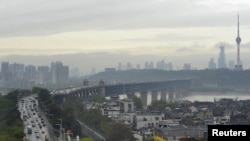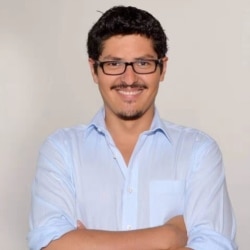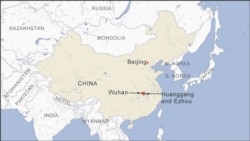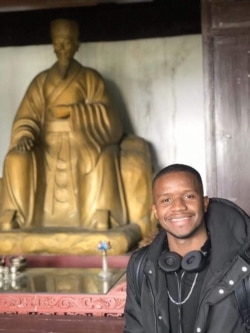Wuhan is where Mao Zedong, then 72, swam in the Yangtze River in 1966 in a display of vigorous health just before the onset of the Cultural Revolution.
Augusto Ignacio Araya Heredia has lived in Wuhan, a second-tier megacity of 11 million in Central China, for three years now. Compared to his hometown of Concepcion, Chile, Wuhan is too humid, Ignacio said. And he copes with Wuhan’s harsh winters by traveling outside China.
Ignacio, 34, is a Ph.D. student of international relations at Central China Normal University (CCNU), one of Wuhan’s 83 institutions of higher education. That total puts Wuhan in second place, after Beijing, which has 94. According to official numbers, there are at least a half-million students in Wuhan.
“Wuhan [is] a perfect place to get to know more about China,” said Ignacio, who previously studied in Beijing at Renmin University before moving to Jiang Cheng, or “the city of rivers,” so named because of Wuhan’s location at the confluence of the Yangtze and Han rivers.
Future city
Dr. John Givens, an assistant professor at Kennesaw State University who teaches courses on China and Asia, has traveled extensively in China for research. He told VOA Mandarin that for international students who are trying to become fluent Mandarin speakers, Wuhan might be a better choice than Shanghai, where, like Beijing, many languages are spoken.
“Everyone’s like ‘You have to try this new Montreal-style deli,’ ” Givens, of Shanghai, said. “You are not going to get that in Wuhan obviously.”
Less international doesn’t mean Wuhan is less modern. The city just hadn't registered with many people outside China, unlike the first-tier cities — Beijing (population 21.54 million) or Shanghai (24.24 million) — unless they recalled Mao's swim in the Yangtze.
Then, weeks ago, the coronavirus outbreak put Wuhan in the spotlight.
Givens said it’s hard for Americans to understand that a city as big as Wuhan isn’t a big deal in China, “because 11 million people is not second-tier in the United States. Most Americans were like, ‘Oh, I’ve barely heard of that place,’ yet it is bigger than the biggest city they’ve ever been to.”
It is, indeed, big. By area, it is more than twice the size of Shanghai and eight times bigger than Hong Kong.
Today’s Wuhan consists of three boroughs — Wuchang, Hankou and Hanyang — merged by the Kuomintang government when it moved its capital from Guangzhou in 1927.
The borough of Hankou was slightly different because it had foreign concessions, or land leased to the United Kingdom, France, Germany, Russia and Japan from the late 19th century to the early 20th century.
Wuhan has, historically, always served as a transportation hub. Besides the busy waterways, most of China’s major train routes go through the city, as does the fast-developing, high-speed train network. Millions of Wuhan residents commute by bicycle, and the city was the first in China to set aside bike lanes.
Tom Murphy, a former mayor of Pittsburgh, Wuhan’s sister city in the U.S. state of Pennsylvania, has witnessed striking changes in Wuhan through his dozens of visits between 1996 and 2019.
“[People] might have an impression that this is a more agricultural town or something like that, because of how this virus has moved from an animal market to the people,” but that’s not true, Murphy said.
“I saw Wuhan go from a very industrial and polluted city to a very modern one,” said Murphy, who visited Wuhan just six months ago.
'Livability' factor
An urban development expert, Murphy said Chinese city planning focused more on “housing people and creating workplaces” instead of “livability,” or the notion that a city is an environment where people go to enjoy themselves. But over the years, Wuhan has evolved, with lush parks now lining the riverbanks in many areas.
“The waterfront or riverfront you see in a lot of cities in the U.S., Pittsburgh included, which was (at) one time a very industrial waterfront, is all being converted into parks,” said Murphy, who added he was delighted to see Wuhan embrace the trend.
People, particularly older people, get up early in the morning to do tai chi, guangchang wu (public dancing) or other forms of exercise in public parks.
“It’s a great sense of community,” Murphy said. “So creating places where that can happen is really important to a community.”
Not far from the parks in Hankou, there is Wuhan Tiandi, a wooded, mixed-used commercial and residential district modeled after Shanghai’s Xintiandi, which was one of the first urban neighborhoods in China developed around historic buildings. In Wuhan Tiandi, some of the buildings are old and repurposed, others are recreations of traditional buildings, and the project, completed in 2009, includes the first air-conditioned outdoor food street in China, according to promotional materials.
Wuhan authorities have even bigger ambitions than creating a livable city. They want to create a “Future City,” building on history. During the final years of the Qing dynasty (1644-1911), a leading official, Zhang Zhidong, used Wuhan as the base for modernizing China’s armies and industries using Western technology.
Today, in the borough of Wuchang, across the Yangtze River from Hankou, education and technology dominate. Known as the Optics Valley of China, the area, near a large freshwater lake on the east side of the city, encompasses a high-tech development zone, a free trade zone, a biotech industry area, and an optoelectronic information industrial center.
By highlighting its pool of recent STEM (science technology, engineering and math) graduates of the local colleges and universities, while offering companies lower commercial rent and labor cost, Wuhan cultivated a cutting-edge vibe tuned to attract tech startups. According to the Nikkei Asian Review, Wuhan, now China’s eighth-largest city, is home to 3,527 startups, ranking 10th in the nation.
Murphy said he was not sure if there was even one subway system when in 1996, he first visited Wuhan, which he sees as a city with “one foot in the future, one foot in the past.” (Worth noting: The first subway line opened in 2012, and today, Wuhan has nine metro lines, with a daily ridership of more than 2.2 million people.)
“Hubei province has one of the finest museums that I have seen,” said Murphy, who was impressed by the collection of bronze statues and a famous set of ancient bronze concert bells displayed in Hubei Provincial Museum. The bells, and the facsimiles that are played in concerts, have accrued 293 “excellent” reviews out of 472 total, which includes 157 “very good” ratings on TripAdvisor.
Yet Wuhan and its attractions remain largely unknown to foreign tourists. Most tourists, as former Pittsburgh Mayor Murphy pointed out, just pass through as it is the endpoint of the Three Gorges Dam cruise tour.
The city’s rich history colors the student experience.
A Chinese student who graduated from Wuhan University, and asked that his name not be used, said: “It's a bit dramatic, but I indeed felt like it was a transcentury experience studying there.” He remembered every morning, leaving tube-shaped dormitory buildings constructed in the 1970s or '80s, walking past engineering department buildings made in the Soviet style or even left from the Republic of China era (1912-1949), only to arrive at a library notable for its futuristic architecture.
International hub
But many international students know little about Wuhan before enrolling in classes. Azerbaijan student Jamal Agharzayev is an undergraduate at the same university as Ignacio, the Ph.D. candidate.
“Why Wuhan?” Agharzayev asked, laughing. “Actually, I didn’t choose that city by myself.”
Like Ignacio, Agharzayev is on a Chinese government scholarship. The government picked Wuhan and CCNU for him, and he doesn’t know why.
It’s a similar experience for Cambodian student Pen Barang, 30, who is working on a master's degree in curriculum and teaching methodology.
“I applied for a scholarship to China with three different universities and I was selected by CCNU, in Wuhan. I had no idea about Wuhan before I made my decision," he said.
With Chinese government scholarships, Pen Barang, Agharzayev, Ignacio and many other international students get a tuition waiver, free on-campus housing, a monthly stipend and medical insurance during their academic career in China.
The scholarship program favors students from countries that are part of China’s “Belt and Road Initiative” (BRI). On the official website of the China Scholarship Council, a category called “Silk Road Scholarship” is specifically for students from those countries. Being able to speak Mandarin is not a requirement.
Though Agharzayev speaks Mandarin well, having studied it at home, he said some of his fellow students who are still learning the language struggle in the many classes taught in Mandarin.
Because of the BRI, an estimated 4,600 students from 12 African countries study in Wuhan, according to international development consultancy Development Reimagined.
Wagner Pereira, 26, is from Cape Verde, an island nation in the central Atlantic Ocean. He is in the computer science master's program at Huazhong University of Science and Technology, a prestigious school in China, and a rival to Wuhan University, another top school in the city. According to U.S. News rankings of Best Global Universities in China, Huazhong University of Science and Technology ranks ninth, while Wuhan University ranks 12th.
Pereira, who receives a government scholarship, said he wasn’t assigned to Wuhan, but he picked the school because of its engineering department. He likes the big, scenic campus. Nearby, East Lake is his favorite spot.
Ignacio, who can navigate the city like a local, praised the convenient public transportation.
"I usually use (it) to go to places such as Hankou, where you can find beautiful parks and really nice coffee shops," he said, adding that he sees changes in Wuhan every single day. And “although Wuhan is a big city, it is still not international enough.”













